Red-Bellied Black Snake
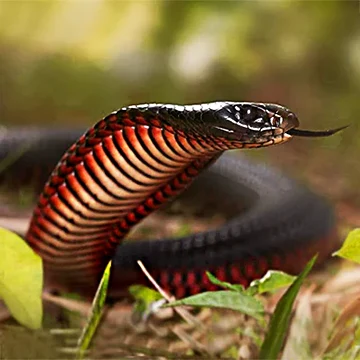
Contents
Red Belly Black Snake Description
The red-bellied black snake is a medium-sized venomous Australian snake with a glossy black upper body and vivid crimson-red sides and belly. Its head blends in with its body and lacks a visible neck area. The red-bellied black snake has a pale brown snout with eyes with no eyelids, round pupils, and a noticeable brow ridge. It is deaf and has a forked tongue. An adult red-bellied black snake can grow to 1.5 - 2m in length.
While this snake is frequently called the Red Bellied Black Snake and Red Belly Black Snake, its correct name is Red-bellied Black Snake. Its scientific name is Pseudechis porphyriacus.
Red Bellied Black Snake Habitat & Distribution
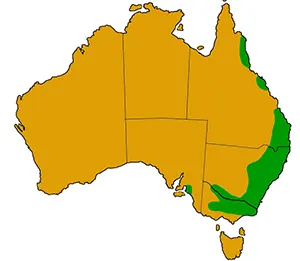
Photo: Red-bellied black snake distribution map
Red-bellied black snakes are native to eastern Australia from south-eastern Queensland through eastern New South Wales and Victoria. They are found in:
• Moist forests, swamps, and woodlands
• Areas near rivers, creeks, wetlands, and dams
• Rural areas, often near irrigation canals
• They rarely venture more than 100 meters from water.
They are active mainly during the day and warm evenings and nights, and shelter under large rocks, in logs, in burrows and clumps of grass when not active.
Red Bellied Black Snake Diet
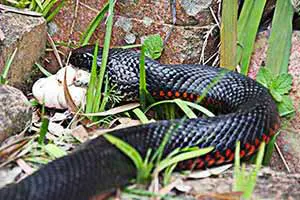
Photo: Red-bellied black snake swallowing egg
Red-bellied black snakes eat frogs, tadpoles, lizards, fish, eggs, small mammals and other snakes—including members of their own species. They may sometimes slither up trees for several meters in search of prey.
This snake is known to forage in water, where it may swim underwater in search of prey. It can stay submerged for as long as 23 minutes. Captured prey may be swallowed while still underwater or, if large, brought to the surface to be eaten.
Red Bellied Black Snake Reproduction
Red-bellied black snakes mate in spring, typically around October and November. Males fight for access to females, engaging in a fierce jousting battle. They rear up, twist around each other, hiss, and even bite, though they are immune to their own venom. The fight usually lasts less than 30 minutes, with one male conceding defeat and retreating.
After mating, females give birth in 4-5 months, producing 8 to 40 live young, each born with venom as potent as their parents'. However, most hatchlings don't survive, falling prey to birds, other snakes, or frogs.
Red-bellied black snakes reach maturity at 2-3 years and can live up to 6 years.
Red Bellied Black Snake Attack
Red-bellied black snakes rarely attack humans. If the snake feels threatened and cannot flee, it may:
• Try to intimidate its opponent by flattening its body and hissing loudly.
• Make mock strikes with a closed mouth.
• If provoked further, it will attack, biting and injecting venom into its victim.
• It may also cling to its victim and chew vigorously.
Can a Red Bellied Black Snake Kill You?
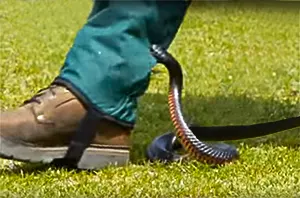
Photo: Red-bellied black snake biting a human
Even though the red-bellied black snake accounts for 16% of all snake bites in Australia, there have been no recorded human deaths caused by a red-bellied black snake bite. Its bite can be extremely painful but rarely life-threatening. Most victims experience mild to negligible symptoms, such as bleeding and swelling at the bite site, nausea, vomiting, headache, diarrhoea, muscle pain, and general weakness. The victim may also pass red-brown urine caused by muscle damage.
Red Bellied Black Snake Venom
The red bellied black snake is ranked as the 10th most venomous snake in Australia. Its venom has:
• Neurotoxins which destroy nerve tissue
• Myotoxins which destroy muscle tissue
• Coagulants which cause blood clots and
• Haemolytic properties which rupture and destroy red blood cells.
Red Bellied Black Snake Threats and Predators
The red-bellied black snake is not considered endangered, largely because it has few natural predators. However they do fall prey to feral cats and large birds of prey such as the brown falcons. Juvenile snakes also fall prey to kookaburras. Unfortunately, human fear of snakes leads to many of these otherwise harmless animals being killed when encountered.

Photo: Cane Toad
There was initial concern about the rapid decline in red-bellied black snake populations following the introduction of the cane toad in 1935. The snakes were consuming the highly toxic toads and dying as a result. However, the two species now appear to be co-existing in the wild.
Red Bellied Black Snake Bite Prevention
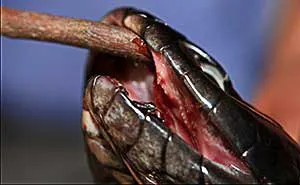
Photo: Red-bellied black snake mouth and fangs
Most bites occur as a direct result of people trying to corner or kill the snake. The best safety measure is the simply leave it alone! Back away slowly and calmly, giving it space to escape. If removal is needed, call a professional snake-catcher. Never touch a snake—even if it looks dead—as it can still deliver a reflex bite hours after death.
When walking in snake-prone areas, stick to clear paths and avoid dense undergrowth. Wearing long pants, thick socks, and sturdy shoes greatly reduces the risk of a bite.
25 Red Bellied Black Snake Facts
- The red-bellied black snake is a medium-sized venomous Australian snake.
- It is about 1.5 - 2m long.
- Some have grown to 2.5 metres in length.
- It lives along the east coast of Australia.
- The red-bellied black snake prefers moist habitats close to water.
- They rarely venture more than 100 meters away from water.
- It hunts on land and in water and can even climb trees.
- It is usually active when it's dark.
- Red-bellied black snakes mostly eat frogs and tadpoles, lizards, fish, eggs, small mammals.
- But sometimes, it also eats other red-bellied black snakes.
- It can stay underwater for 23 minutes.
- Like most snakes, it is deaf and has no eyelids.
- The red-bellied black snake belongs to the elapid family of snakes.
- It has small hollow syringe-like fangs to inject its venom.
- It is non-aggressive and avoids humans.
- It only attacks under extreme provocation.
- But it is the snake most frequently encountered by humans.
- It accounts for 16% of all snake bites.
- Red-bellied black snake venom is low in potency and output compared to other snakes.
- Bite symptoms include swelling at the site of the bite, nausea, vomiting, headache, diarrhoea, muscle pain, and general weakness. And passing red-brown urine.
- No deaths have been recorded from its bite.
- Do not attempt to handle a red-bellied black snake even if it appears dead. It can reflex-bite up to several hours after death.
- It shelters in thick grass clumps, logs, burrows and under rocks.
- Females are ovoviviparous. That means females give birth to live young.
- A red-bellied black snake can live for up to 6 years.
All Rights Reserved. (Last Updated: Apr 09, 2025)
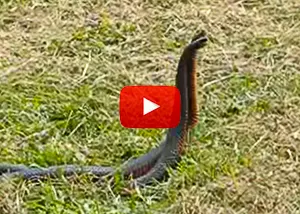
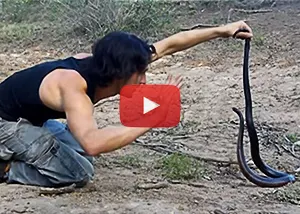 Video of Snake Attack
Video of Snake Attack